How to organize a wardrobe inside
In our homes, we have to solve a difficult task - it is necessary to place many things in a relatively small area. For this reason, we try to use every centimeter of the area to the maximum. A striking example of this is the use of sliding doors in furniture instead of swing doors. Another example is filling a wardrobe. Correctly selected, it allows you to use the entire available volume, and not just the area.
The content of the article
Organization of the inner space of the wardrobe
In order to properly organize the interior of the wardrobe, it would be nice to know what can be put there in general. Most often, the set consists of several shelves, compartments for clothes hangers. There may also be drawers. These are the most common types of filling, but far from the only ones. There are also special hangers for trousers (trousers), skirts (skirts), holders for belts and ties, special shelves for shoes (shoe racks). Moreover, they can be stationary and retractable. They allow you to more compactly place clothes of a certain type and it is always in the designated place.
All these devices are called wardrobe fittings or accessories, but most often the phrase "filling the wardrobe" is used. It more accurately reflects the essence - these are various devices for organizing the space inside.
Shoulders and crossbars
Rails for hangers can be located parallel (1, 2, 4) or perpendicular (7) relative to the cabinet doors. It is more convenient when the crossbar is parallel to the door - all the things that hang on it are visible. But in this case, the depth of the closet cannot be less than 60 cm - clothes hangers take up just that much space.
If the crossbar is located perpendicular to the door, the cabinet may be less deep - 40-45 cm. But in this case, only the first thing is fully visible, all the others are hidden behind it. Not very comfortable. The problem can be solved by installing a retractable system. In this case, it will be much more convenient to use.
It is often more convenient to place the compartments for clothes on the hangers in the upper part of the wardrobe, leaving the lower part for shelves and drawers. In this case, they put not ordinary crossbars, but movable ones. This device for filling wardrobes is called "pantographs".
There are different sizes of pantographs, but if you want to equip with a ready-made, and not individually made option, check the dimensions in advance and "adjust" the width of the compartment for them. After all, you still need to leave a place for fastening the mechanism.
Shelves and drawers
Filling a wardrobe is rarely complete without shelves and drawers. Shelves with a wardrobe are made of different depths and heights - it all depends on what you plan to stack on them, but the minimum shelf height is 30 cm. Several sweaters and T-shirts can be placed on it.
Most often, shelves are made of laminated fiberboard, but mesh shelves can be installed. They take up very little space (in thickness), which is also a plus in case of problems with dimensions. The second positive point - if the mesh shelves are high, you can see from below what lies there (at least partially). Their disadvantage is the fixed sizes that will have to be taken into account when planning. Although, a small error can be corrected by means of strips on which these shelves can be laid.
Drawers can also be from Chipboard or mesh. The advantages and disadvantages are the same. In some cases, mesh crates are called baskets. Lightweight and comfortable, they do not accumulate dust.
Devices for compact placement of things
Most of the time, there is not enough space in the closet. Even if they are of decent size. Therefore, they try to develop the filling of the sliding wardrobe so that the available volumes are used rationally. For example, instead of traditional shelves for shoes (mesh or chipboard), you can put a retractable shoe rack. They perfectly accommodate low-rise shoes - shoes, sandals, boots.
Due to the fact that the shoes are stacked obliquely, it is better seen. If you use mesh shelves for shoes, due to the fact that the heels "fall through", space is significantly saved.
Many problems arise with the storage of trousers and jeans. For this type of clothing, there is also a special device, which is often called "trouser". These are pull-out straps on which double-folded trousers hang.
Usually they are placed under the shelves at waist level, or at shoulder level. Above not worth it - inconvenient. It is better to place a pantograph or shelves for rarely used things in the upper part of the wardrobe.
Also in the filling for wardrobes there is a device for storing ties and belts. On the same devices you can store scarves, mufflers, etc. This hanger is similar to a trouser, only it is smaller.
It is more convenient to place them on the side in the section for clothes. They are about 15-20 cm wide, so they won't take up much space. Another option for placing such things is a drawer, divided by partitions into small squares.
What else is worth saying about the filling for wardrobes? At firms that make furniture, all (or almost all) sliding systems are solid. Each device also increases the cost of installation. If you have at least a little skill with a drill and screwdriver (or with a screwdriver), you can mount it yourself by purchasing these devices from the company. It will be a little cheaper. You can save more if you buy them through online stores or directly from China.
These are all the devices that are used when filling wardrobes. The main thing is to place them correctly, to determine the sizes of sections and doors.
Planning the insides: technical points
To develop the internal structure of the wardrobe, it is necessary to determine the amount of clothes of various types that you plan to put in this particular furniture. For certain volumes of different types of clothing, the filling of the wardrobe is being developed. It will greatly depend on the location of the built-in furniture. For example, if the wardrobe is in the hallway, it is necessary to allocate space for outerwear. Since coats and raincoats are long, this compartment should also have a large height - 130-150 cm. You will also need to set aside space for storing hats / gloves / scarves.
Such departments probably won't be in the bedroom. But here a TV can be built in (there are also sliding wardrobes), which in the corridor will be absolutely useless. In general, think carefully about what you are going to store in each specific wardrobe, measure the size of large-sized items, add at least 10 cm to freedom of action and put these dimensions on the plan.
When determining the height and width of the shelves, do not forget to subtract the thickness of the chipboard if the furniture is assembled from this material. It only seems that 18 mm is not much. If there are, for example, five shelves, then the material will take almost 10 cm in height.
When determining the size and number of doors, dividing the wardrobe into sections, pay special attention to the sections that have pull-out systems.The fact is that the doors are not exactly 1/2 or 1/3 of the cabinet width, but slightly larger. Specifically - more by twice the profile width. That is, if you have three doors in a 180 cm wide wardrobe, then opening one of them, you will get less free space than 60 cm.
Therefore, the width of the drawers (and the sections in which they are embedded) should be slightly less than the width of your doors.
And the second point concerns the depth of the cabinet. If a pantograph or a holder for a hanger with clothes is installed, the minimum width is 60 cm.When installing a retractable hanger for a hanger, 45 cm is enough.But note that the retractable structure itself should be no more than 40 cm in length - more space is needed for freedom of movement doors.
Popular options for filling the wardrobe
As you understand, there can be a lot of options here, but there are several basic configurations that can be modified to suit your own desires.
What departments should be
Conventionally, the entire height of the wardrobe can be divided into three zones: lower, middle, upper. Shoes, some types of household appliances (vacuum cleaners, for example) are usually placed in the lower zone. At the top, high mezzanine shelves are most often made, which are used to store things that are rarely used. You can also put out non-seasonal items there.
The entire middle part is usually occupied by shelves, drawers, and hanger sections. Here you usually have to tinker with their placement. So that everything is convenient for all family members.
How to organize a small wardrobe inside
Any filling of a wardrobe compartment in the overwhelming majority of cases has a certain number of shelves and compartments for hangers. This is the simplest and most economical option. Usually they are two-door - the recommended width of the door leaf is no more than a meter, which is observed in this case. The smallest wardrobe is just over a meter wide. They are usually installed in the corridors of small apartments. Two doors are also made in the event that the length is slightly longer - up to 180 cm.
There is not much variety here, but it is quite possible to install a couple of boxes if necessary. Retractable devices for compact placement will come in handy here. The groom will definitely need it.
Medium size
If the width of the wardrobe is 180 cm or a little more - about 2 meters, it is most often divided into three sections. These models are also called three-door models, since most often the number of sections coincides with the number of doors. With a width of 2 meters, each of the sections is about 60 cm wide (including partitions). This is a fairly convenient format - not too wide and not narrow, with such a shelf length there will be no problems with chipboard sagging even if its thickness is 14 mm.
By increasing the length of the cabinet to 270 cm, it can still have three doors - the door width is still less than a meter. But at a high height, such doors are already quite massive and require good fittings (guides and wheels must be of good quality so that the slide is smooth). So already with a width of more than 240 cm, 4 doors can be planned. In this case, there can be three sections. You just have to move two doors to access each of them.
The first and third sketches consist only of shelves and a compartment for clothes on hangers. The place is distributed in different ways, but there are a lot of shelves. All others have added drawers and / or lattice baskets.
The boxes can be located at the very bottom. Relying on the lower part, they give the whole structure increased rigidity. But the lower drawers are not very convenient to use - you have to bend low. Therefore, more often they are raised higher so that they are approximately at a level above mid-thigh or at waist level.But in this case, a reinforced lintel is needed under the lower drawer - to give greater rigidity to the entire structure.
Pay attention to the mezzanines - the upper compartments. In the above options, they are the same size as the sections, but this is not required. If necessary, one mezzanine can be located above two sections. It is only important to correctly calculate the thickness of the material for the shelf so that it does not bend.
Sliding wardrobe for 3 meters
With a wardrobe compartment length of 3 meters, 4 sections are made, and there may be more doors. There is more space, but there is not much difference in the filling. Just more of the same shelves, pantographs and drawers / baskets. There can be a lot of combinations. Choose the option that suits you best, but you can also change it - according to your needs and tastes.
A few more options for the internal filling of large cabinets in the photo gallery. There are some interesting ideas for organizing storage on open shelves - in baskets or plastic boxes. This, by the way, is a budget replacement for drawers, as well as a way to modernize the filling of a sliding wardrobe without problems and special costs. If you decide that there are few boxes, but there are many shelves, you do not have to order boxes and suffer with their installation. A good replacement is boxes or baskets of the right size.
- Pay attention to how the shoe racks are installed
- Regular drawers at the bottom for easy viewing, and wire baskets above
- There is even a compartment for storing household chemicals - in plastic trays mounted on the wall
- Cantilever shelves do not belong to the insides, but they are convenient for placing small items
- This option has more boxes
- Narrow boxes and wide baskets are also an interesting option.
Internal arrangement of the corner wardrobe
To make the corner cabinet convenient to use, it is necessary to ensure the accessibility of things located in the corner. The easiest way to do this is with a coat hanger. There are several options. The easiest to implement is to install two clothes rails without a partition between the sections. In this case, the width of the cabinet on both walls should be the same, and the missing rigidity is added by the rack, to which the crossbars are attached.
The second option is that one part of the closet has a shallower depth and it will be possible to place outside clothes “behind the wall”. It is not used very often.
And another way is to install a rotating stand in the corner. They can be found in shops that specialize in commercial equipment.
Only choose a model with a stand - it will support the shelves from above, giving rigidity and stability. The rest of the filling of the wardrobe is not much different.

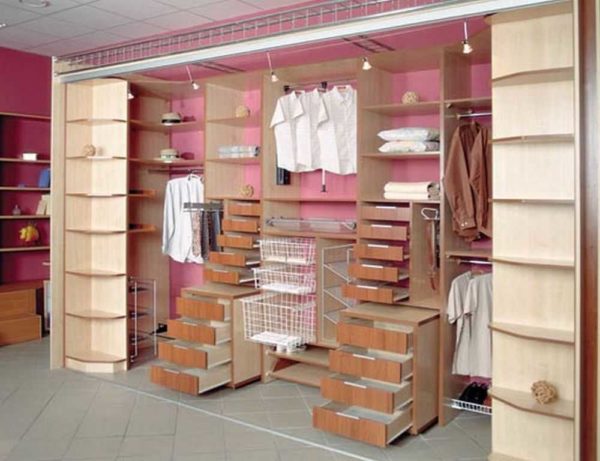

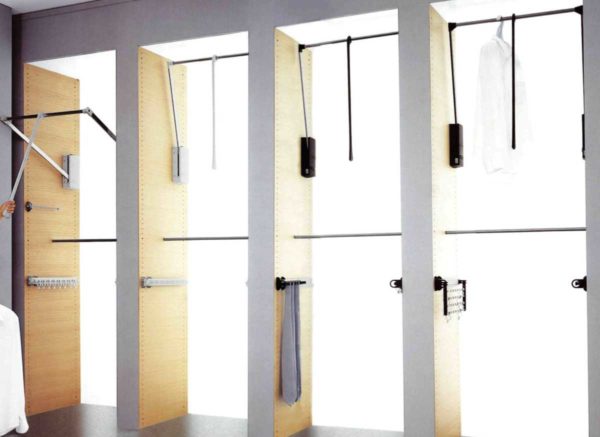
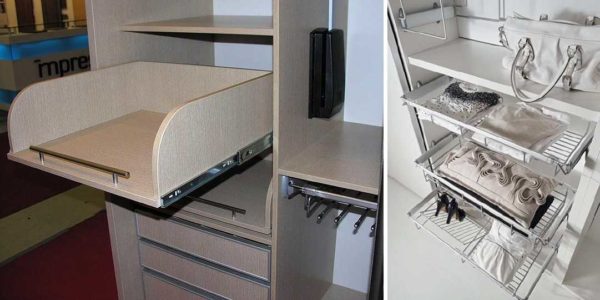
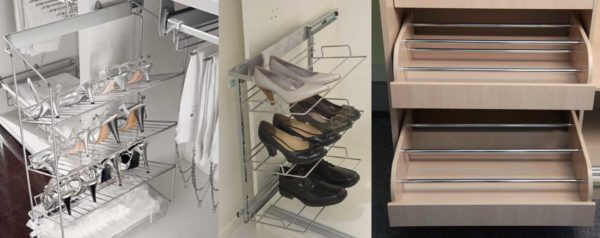
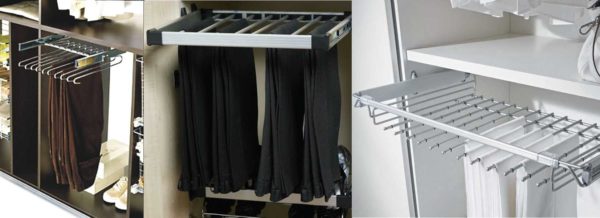
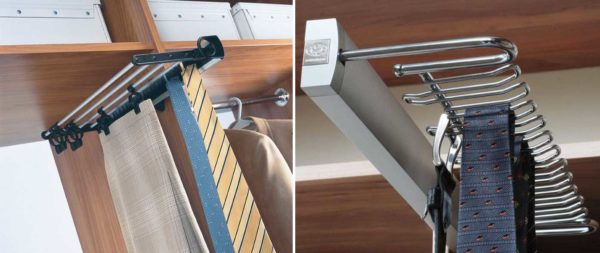
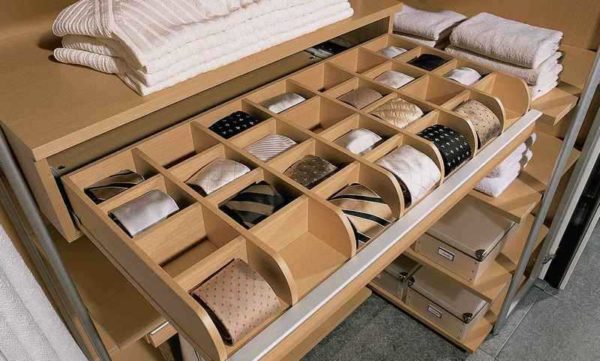
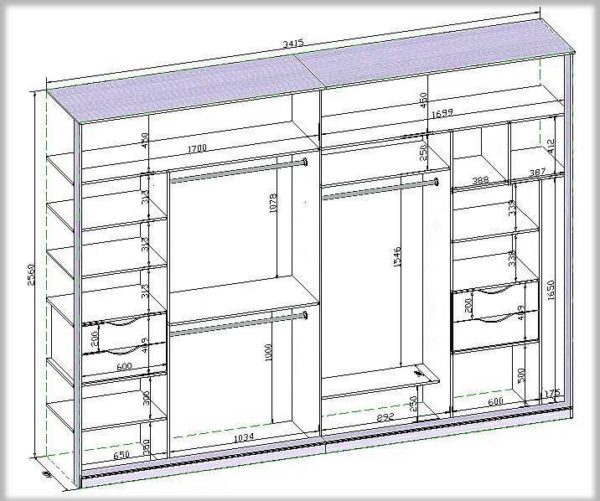
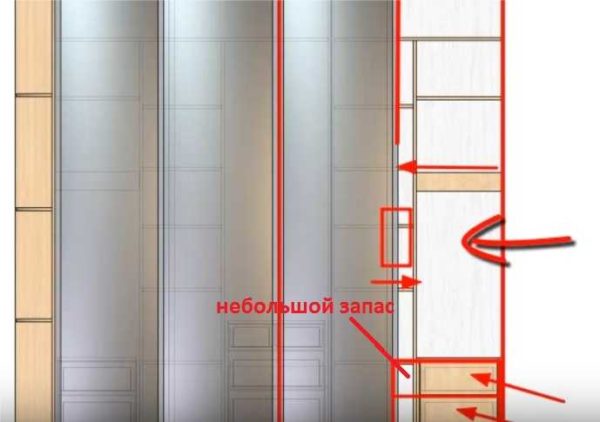
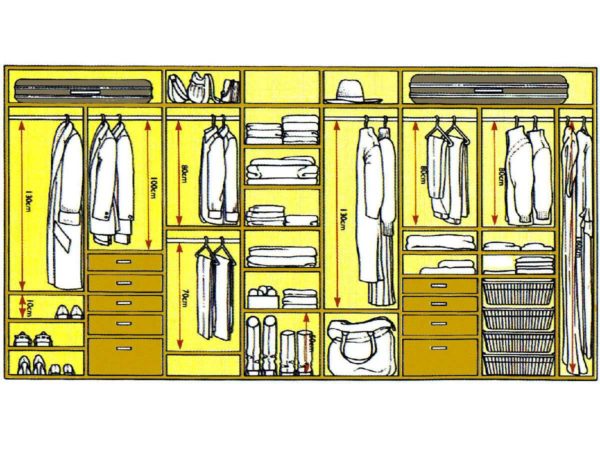

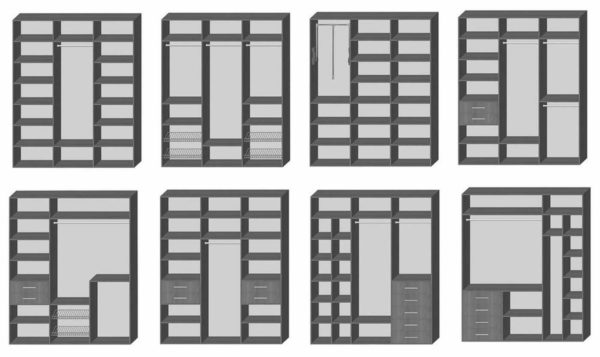
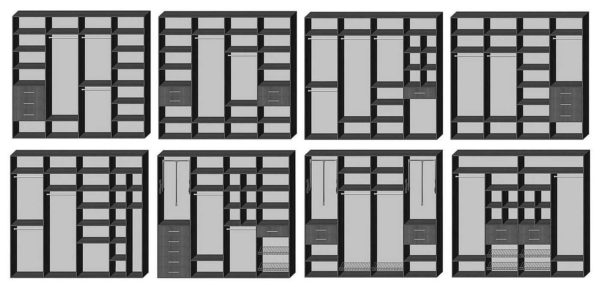
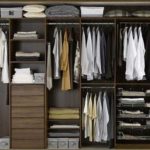





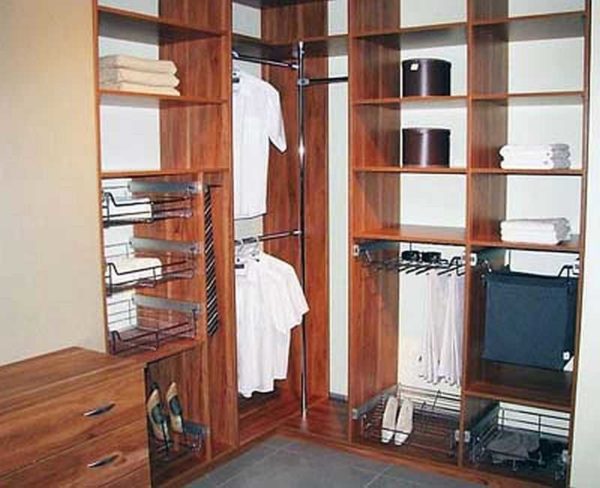
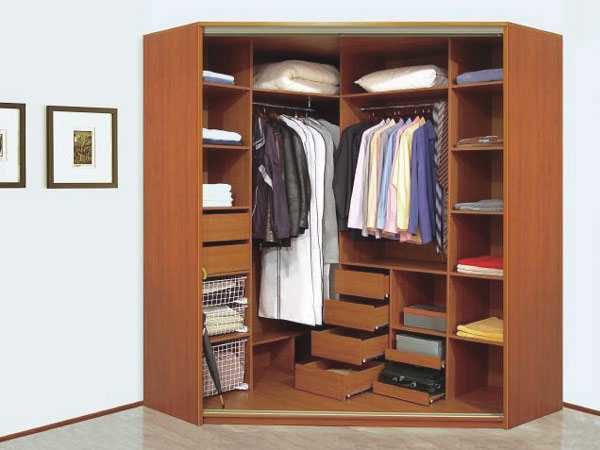
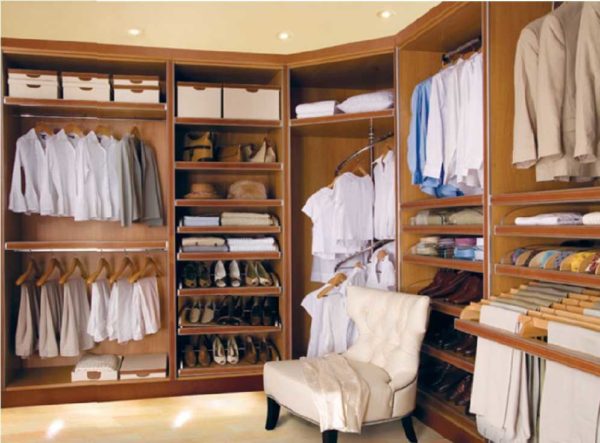
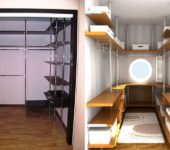

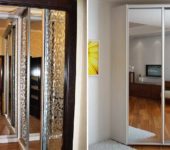
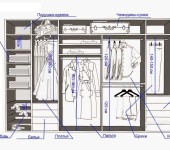





Thanks for the article, detailed explanation and help in choosing the right items!
Thanks for the helpful article!
Thank you for your feedback! We try))
Hello! Do you have any suggestions for non-standard cabinets? In a small apartment there is a niche more than a meter deep and 65 cm wide. Height 260 cm. I would like to hang clothes and storage shelves there. But here I twist it and everything will be uncomfortable.
Hello! You have a really awkward niche option - normal depth and small width. All that comes to mind is to install a pantograph on the back wall from a level of 90-100 cm and above, drawers and open shelves under it. Above the pantograph and make shelves of normal depth (this is 45-55 cm) for storing rarely used or bulky things.
You can also try at the same level (above the door lintel) on one of the side walls to make very shallow shelves - 20 cm ... But there is no certainty about them. Most likely, they will be of little use ... except to put shoe boxes sideways. But then you can not shelves, but a couple of pipes or a grid ... And they will not "press", and you can see what lies there ... Something like this.